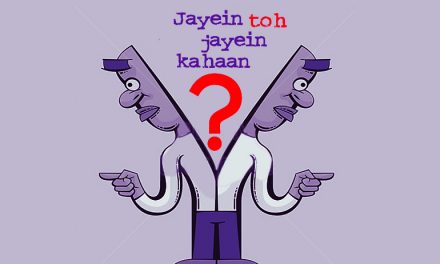IIFT 2016-18 was along the expected lines, it appears that the paper setters went through my blogpost GP’s 10 foolproof fundas to Crack IIFT and implemented everything that was mentioned. So all the key ingredients of IIFT papers like “match the following” questions, the South Indian Thali, lengthy but factual RCs, difficult DI sets and, most importantly, incorrect questions (13 incorrect or ambiguous questions) were all available in the paper.
You may view the analysis of IIFT 2016-18 paper here.
If we have to compare IIFT 2016-18 analysis to old IIFT test papers, then the closest will be IIFT 2014-16. Not only do these two papers have the same structure (combined EU+RC and DI+LR) and marking scheme but also four out of six sub-sections of these two papers are similar in terms of the degree of difficulty, the question types and also the possible attempts. The two sub-sections that have deviated from the 2014-16 paper are GK and DI which are similar in terms of structure but have a higher level of difficulty.
Hopefully you would have calculated your IIFT score, if not then you can do using the CL IIFT Score Calculator.
Let us now look at each section in detail.
General Knowledge
28 questions @ 0.5 marks per question = 14 marks
The GK section was along the expected lines and with questions from all topics. Unlike IIFT 2014-16 paper which was easy and candidates with decent GK could have comfortably attempted about 15 questions, this year the level of difficulty went up and candidates with decent GK would have attempted only around 10 questions in about 8 minutes. What would have given relief to the candidates were the 6 match the following questions as most of them could have been solved with a single match.
In IIFT 2014-16 the sectional cutoff for GK was 1.8 marks and with a higher level of difficulty I expect the cutoff to be in the region of 1.5-1.8 marks or 4 net correct answers were sufficient to clear this section. CL students who went through the GK section of Mock IIFTs and the GK compendium would have found at least 6 questions from there which was sufficient to clear the sectional cutoff.
English Usage and Reading Comprehension
EU 20 questions @ 0.75 marks per question = 15 marks
RC 16 questions @ 1 mark per question = 16 marks
English Usage: As usual vocabulary based questions comprised half the questions in this section. A couple of questions each of Parajumbles, Idioms, Phrasal verbs and figure of speech completed this section and one could have comfortably attempted 16-17 questions in about 15 minutes. A few questions had close choices and would have led to 3-4 errors but a score of around 10 marks was easily achievable.
Reading Comprehension: The four long RC passages with a majority of questions being factual in nature made this a regular IIFT RC section. Attempting 3 RC passages in about 20 minutes was possible. Some students even came back to do an extra passage after realising that DI was extremely difficult and attempted almost all 16 questions of RC.
While candidates strong in EURC would be scoring 18-20 marks and a score of over 15 marks was not difficult I expect the EURC cutoff to be around 6.50 marks.
Logical Reasoning and Data Interpretation
LR 20 questions @ 0.75 marks per question = 15 marks
DI 18 questions @ 1 mark per question = 18 marks
Logical Reasoning: Students would have breezed through this section, except for a data set (exporters – USA, UAE, UK) in which 2 questions are incorrect and hence would have led to time wastage, all other data sets and single questions were easily do-able and the section could have been easily completed in a 25-30 minutes leading to a net score of 11-12 marks.
Data Interpretation: The low level of difficulty of LR was compensated by a very high level of difficulty of DI. The DI section in this paper reminded me of the old IIFT papers in which an attempt of a 3-4 questions in about 15 minutes was an achievement. It would have been painful for most candidates to move from set to set and hardly find a DI set or question worth attempting. Added to this is the fact that two of the four data sets had typographical errors and questions could not have been solved without making assumptions.
Most of the candidates would have settled for the data set with a “multiple bar chart on scores on Competitiveness Factors” leading to an output of 3-4 attempts in 10-15 minutes.
A cumulative score of around 15 in LRDI was possible but the sectional cutoff would be around 8.5 marks.
Quantitative Aptitude
QA 22 questions @ 1 mark per question = 22 marks
This section too was along the expected lines, simple questions made to look difficult by converting 2 line questions to 8 line ones. Most of the arithmetic questions were straight forward and the algebra questions could be easily solved by substitution of choices. IIFT did not disappoint us wrt incorrect questions, there are 3 questions that are either incorrect or ambiguous or in which none of the choice is correct.
About 15-17 questions in 35 minutes was possible in QA and the cutoff should be in the region of 6.5 marks.
The Final Word
The fact that IIFT has a complex structure but simple questions means that it is a test of temperament and not knowledge. Hence the candidates who did not get flustered with the difficult DI and were able to reallocate their DI time to RC would have done well and should be expecting IIFT interview call. General Category candidates with an overall score of around 45 with the sectional scores in excess of the cutoff should be short listed by IIFT for the next stage. The overall cutoff for NCOBC candidates is expected to be around 40 and that for SC, ST, PH candidates around 35.
IIFT test results are typically declared by end December and the interviews are conducted one month later, hence the candidates expecting IIFT calls should start their PDP sessions immediately after CAT, waiting for results or XAT will not allow you sufficient preparation time.
All the best,
GP












Hello, my paper went pretty bad since I wasted a lot of time on LR, but I am expecting to clear sectional cut offs but not overall cut off. I am expecting around 36, is there any chance for Kolkata campus?
Megha, the cutoff for both the campus is the same.
According to Cl score calculator OA-48.76 Quant- 11.34 DI/LR- 16.51 RC/EU- 16.24 GK- 4.66 What are the chances? But I have a doubt Account. to IMS/TIME My Overall score is 46.44. Any discrepancy in answer key of CL.
Tushar, pardon the delay. I hope you got some good calls this year.
Sir,
I would like to appear for IIFT entrance exam, please suggest me good books..
Dip, my suggestion is to go for the following two books:
1. MBA Guide (XAT, IIFT, NMAT, SNAP, CMAT)
2. IIFT Year wise & Section wise Solved Paers 2006-2015 (Includes Full Length Model Papers)
Sir This year I converted iift kolkatta . Classes are going to start in 10 days and I am still not sure of joining . My profile : GEM 93/84/91/12 months . I am unable to prepare for cat 2016 due to horrible timing in office . I am stuck . I don’t know what to do next . People mention discrimination at kolkatta campus . Events also happen mostly in Delhi campus . What should I do ?
Dhaval, it is a decent convert. You should not be in dilemma about your decision. You should focus on your course in IIFT Kolkata. It is at par with IIFT D. there’s no disparity between these two institutes as they have common placements.
Sir, I am preparing to appear for MBA exams this year, will be giving IIFT 2016.I attempted the IIFT 2015 question paper within the stipulated time and secured the following marks.
GK: 11.17 , EURC: 24.66 , QA: 15 , LRDI: 15.32(10.66+4.66) Total: 66.15
Please tell me where do I stand and what preparations do I need..??
Anand, 66 is a good score in IIFT. Considering that you took it in the comforts of your home, your real exam score at the center would have been 10-15% lower. You are in a good stead to crack IIFT and the other MBA exams.
You can refer to our STUDY PLAN for better preparation.
Good luck!
Thank You Sir , for the valuable advice..
SIr,
I have just completed my MBA (age 23) from one of the top 10 B school and got placed in a top MNC with 14 lakh Package. Is IAS is a right option now?
Vicky, totally depends on what you want from life. If you think IAS is your calling then go for it.
With 85.41 percentile, how likely is it to convert iift delhi in st category(female)? Will the wat gd pi score be decisive in making into the final convert list?
Aditi, the selections will be done purely on the basis of entrance exam. There is good chance of converting IIFT.
Hi GP Sir
I got 52.78 in IIFT and cutoff is 48.5, wht are my chances to convert iift delhi call?
TIA
Rajan, chances are good. Please start preparing for the round 2.
Does IIFT by any chance release a second list ?
Anurag, a second list is unlikely.
Sir , Can you suggest what has been the minimum score to get a call from IIFT ?
Yash, a score of 48.5 was required for General category.
Sir I have been shortlisted for the next roundfor IIFT. I got a 98.17 percentile. What should be my strategy to maximise my chances of converting the call ? My dream is to studyin IIFT Delhi.
Anand, focus on revising the current affairs and specially business related news. You could consider joining the PDP Program.
Sir, CL predicts my score at 47.92. However, scored only 2 on GK. Any chance of getting a call then?
Charu, score of 2 in GK is borderline but it is likely that you will get a call. Also, focus on XAT. Start your PDP prep.
My IIFT score is 46.91 or 48.24 !
GK is 2.34.
Can I expect a call for GDPI ?
Rohan, IIFT Delhi call is most likely. Start your PDP prep.
Sir,
My overall score is 46.76. Is it a borderline case?
Ramesh, it is borderline however chances are that the cutoff might get to 45 which will help you get through.
GP Sir I am getting 46.20 with sectionals cleared..Will I get a call from iift?What is expected cut off from yourside?
Raj, it will be borderline. Chances are that you’ll get the IIFT call. The cutoff is likely to be 45-47.
Respected sir
My iift score as per the official keys
quant – 12
varc – 20.xx
lrdi – 13.5
gk – 2.67
oa – 48.34
Will i get a call? and Assuming if i do , Do i stand a chance for the final selection? Please reply , very tensed.
Abhishek, you will get a call from IIFT, start preparing for the next stage.
Sir,
My OA is 44.77 as per CL and Official IIFT key.
VARC- 18.5
GK – 4.77
QA – 7.33
DILR – 15.25
I am bit sceptical about my OA and QA marks. Can I expect to clear cut offs and start preparing for GD-PI.
Sid, your OA score is on the edge but QA is not a problem, hopefully you will get a call.
What is the ideal time to start with PDP classes ?
Atul, as soon as you get an idea that you’re getting a percentile worthy of a call. Use the CL Percentile Predictor to get an idea about your percentile.
Hi sir,
Acc to CL keys…QA 8.02, GA 5.5, Verbal 13.26 and DI/LR 20.34… OA 47.12 …What are my chances..Worried About OA and QA score? If it is enough for the call then how should I start my preparation for GD/PI.? And Your blogs on other exams test taking strategy were very helpfull..Please sir write a similar blog for SNAP test taking strategy..
Lovepreet, your QA and OA scores are fine and you should be getting a call from IIFT. Start your PDP classes asap.
Sir
I am getting 46.27 with sectionals cleared. As you said that I can get a call.Can you suggest me what should I do for GD-PI preperation.
Atul, you should start self introspection about your life, your achievements and your goals. You need to be abreast with the happenings around the world. You could consider joining CL’s PDP Program.
Sir my overall score is 47 and section wise I am clearing the cutoffs except in qa where its only 4 marks..
Is there a chance of a call??
Rohit, 4 marks in QA is pretty low and it is unlikely that you’ll receive a call.
Sir
My quant score is 6.67 and OA 50.51. What are my chances for iift?
Abc, your Quant score is borderline. There are good chances that you may just clear the cutoff.
Hello GP Sir,
I am deeply thankful to your blog post about cracking IIFT. Your 10 tips which mentioned the exact time to be given to each section helped me a lot during exams.
When I started preparing for IIFT , looking at the past papers made my dream of getting into iift fade away. With your tips and guidance I completely changed my attitude towards the exam which boosted my confidence and was able to score consistently well in my mocks which reflected in my actual exam too. I was able to score 46.78 in my exam (clearing all sectionals ). Even though its not a high score but considering my CAT where I never reached a score close to 100/300, its satisfactory for myself.
I thank you from the bottom of my heart and wish to see your future post about the essay-interview-gd as well.
Good luck Sudeep!
Hi GP, thanks for taking time to reply to everyone.
LR/DI- 16.51
RC/EU-17.84
GA-1.83
QA-12
OA-48.2
Chances of me clearing the GA cut-off?
Abhi, you might just make it. Borderline.
Kiran, please refer to the post Jayein toh jayein kahaan 2015: Which Institute?. This is updated periodically.
Sir, With a score of 58.67 (all sectionals cleared according to your analysis)
What chance would i be having at the later stages?
will academics be considered? I have 90+ in 10th and 12th and 85+ in my Engineering, also I am a fresher.
Thank You
Amit, Goo chances for final selection. Academics are typically not considered by IIFT but are helpful in the interview.
SIr my marks,
VARC-15.91
QA-9.34
GK-4
DILR-13.26
OVERALL-42.52
Is there any chance for me to get a call considering the no of seats has increased so cut-off may reduce?
Soham, unfortunately call appears to be difficult for you.
GP Sir,
My scores as per IIFT key are :
QA – 9
GK – 2.33
DI & LR – 13.92
VA & RC – 20.33
OVERALL – 45.58
Can I expect a call for the next rounds as I am worried about QA & GK scores ?
Sandeep, I think both are fine and you will get a call.
Hello Sir,
According to the the Official IIFT Answer Key and as per CL too i am getting the following score –
GK – 2.17
QA – 7
LR-DI – 21.25
VA-RC – 18.25
Overall score – 48.68
Is it enough to get GD/PI call ?
Thanks.
Aakash, most probably you will get IIFT interview call.
Hi GP sir,
My overall comes to 46.77
But QA again proved to be an Achilles heel.
Got just 6.01
Any chances to get a call?
Please advise!
Prasanna, your call depends upon QA, if you clear the sectional cutoff then you will make it to the next stage. Let us hope for the best.
Hi Sir,
Many students have written that they are getting marks which are way above the 43-45 score range. Sir do u think that the cut off will be such low?
I have also checked my marks in cl score calculator and found it to be 43.59. Can u tell me what percentile will my marks fetch based on the number of students who entered marks in cl score calculator and will i at all expect calls from iift given that i have 1.67 in gk?
Srv, we can go only by the data submitted by all of you which suggests that the cutoff would be around 45 marks.
Your overall and GK scores are on the edge but hopefully you will get a call.
Hi GP sir,
As per the articles related to xat its being said that there will be negative marking for all non attempted questions.Is it true? how to go about it.
Krish, there is no confirmation from XAT on this issue. Let us wait for a week before commenting on this.
Hii GP Sir,
My overall score is 44.85 according to CL
Score predictor. I have cleared all the sectional cutoffs.
But overall cutoff predicted by you is in the range 45-47.
Should I expect a call from IIFT ?
GV, you are a borderline case and hopefully you will make it to the interview list.
Thanks for your reply Sir.
Is the overall cutoff not expected to go below 45 because of increase in number of seats in IIFT?
GV, it could go down by 1 mark.
sir i’m getting 44.6 overall and sectionals in line with ur predictions. If I get a call what are the chances for converting it.
fresher- 2015 batch nit rourkela cgpa-7.95, 10th-89.6,12th-87.6, no workex
Ruman, you are likely to be very close to the cutoff and hence you will need a very good interview to convert the call.
Sir I am getting 46.xx and all sections cleared..general category…can i get a call from iift delhi?what according to you will be the cut off for general category?
Atul, my estimate of general category cutoff is around 45 marks and you should get IIFT interview call.
Sir, I am getting 44.51( lr-di 9.25, va-RC 16.25, gk-3, qa- 16) and I belong to OBC. Can I expect a call and if yes, how should I prepare for the next rounds
Vinay, you will get IIFT call and you should start your PDP classes immediately after CAT. Will write shortly on interview preparation.
According to the Official key,
RC+VA : 20.67, GK : 3, QA : 11.67, LR+DI : 11.25, OA : 46.59
Can I expect an interview call ? If yes what should I exactly study for Essay/GD/PI ?
Gaurab, yes you can expect a call. Will write a post shortly on the interview process.
Thank You Sir !
Is there any consideration for academics scores and work ex. for shortlisting or is it solely based on IIFT score?
Vijay, it is based on the IIFT score only.
GK – 6.17
QA – 6.34
LR/DI – 15.34
VA/RC – 21
Overall : 48.85
Chances?
Akshay, if you clear the QA sectional cutoff then you will get a call.
Sir, in this scenario should I go for PDP classes? I am based out of Gurgaon. Had multiple queries regarding the PDP classes? Whom can I contact?
Akshay, 6.34 in QA is a borderline case. Let us discuss again after CAT and decide based on your CAT performance.
Click here for PDP details, send me a mail at gp@careerlauncher.com and I’ll connect you to someone who can guide you for PDP.
LR = 10.84
VA = 23.41
GK = 3.67
Qaunt = 7.67
OA = 45.59 (official IIFT keys, and 44.57 by CL keys)
Is there any possibility for getting a call? If yes, then can you guide me regarding PDP sessions? I have very ordinary acads.
Utkarsh, you should be getting IIFT interview call. Click here for PDP program details, please email me your contact details and the city you belong to and you will get a call back.
Where can I get your email ID?
Utkarsh, it is gp@careerlauncher.com
My LR&DI score is 9.85 and gk is 2.67 with OA 48.33. are these scores sufficient to clear sectional cutoff?
Ankit, I think these are sufficient and you will get a call.
Sir,
IIFT has released its answer key. There are answers to every question including the LR one (US,UK set). Does that mean that the wrong/ambiguous which most of us,including you ,thought were there have no relevance since answers are there for all the questions or is there a possibility of iift considering certain questions as wrong?
Ramesh, it appears that IIFT feels that there is nothing wrong with any of the question.
Sir with an overall of 57.67 (by official iift key and cl calculator). QA: 16.67; DILR:18.01; EU+RC 20.17; GK 2.83
Will the Gk Score Suffice? seeing so many who have done well in gk, will i be able to clear the Sectional cutoff?
Ankit, I think 2.83 in GK is sufficient to clear the sectional cutoff.
Hello sir, as per official answer key released, my score is:
VARC: 24.68
GK: 7
QA: 8
LRDI: 10.92
Overall: 50.6
Can the QA cutoff go as high as 8 by any chance? Am i safe? Thanks…
Prithviraj, I think you are safe and should get IIFT interview call.
For admission to IIFT ,a good performance in written and interview is enough or a good academic background is also very much required?
Nishant, IIFT typically has weight for the test, essay, GD and interview hence profile does not play any role except during the interview.
Sir,
I am getting an OA of 53.75 but quant score of 7.34. Will it be sufficient to clear sectional or is it a border line case as majority has done very well in quant can the cut iff go beyond 7 or 7.5?
Neeraj, my estimate is that 7.34 in QA should be sufficient to clear the sectional cuttoff.
Sir,
I am getting 56 in iift as per cl but only 1.5 in GK..what are the chances..and CLPP has predicted my cat percentile to be 97.98 but in the last 3 unproctored mocks im getting only 85 percentile on average..this is hurting my confidence..pls suggest
Vishal, 1.5 in GK is a borderline case but hopefully you will make it to the next stage.
Regarding your Mock CAT performance, please call me at 9811155160 any time tomorrow.
Sir,
you have mentioned that the probabilty question was wrong/ambiguous. So, how has the cl calculator marked that question, as in is it being considered correct with 0.8 as answer or +1 mark is being awarded to everyone?
Raisa, we have given the answers as that we think IIFT will go by since they are unlikely to accept the errors.
And what about that airtel question in which none of the choices were correct? as u have mentioned that its answer was 4.1%. how has the cl calculator dealt with that question?
Raisa, the closest option.
So that means iift wont consider even that question to be wrong???
No
Hi Sir,
As mentioned in the brochure, IIFT seats are increased to 360(220Delhi+140Kolk). So can we expect a call at 43.92OA? As your prediction of 45OA was based on the fact that IIFT is having 260 seats.
Vishnu, I could not find this information in the IIFT brochure, please forward the relevant link or the document. If this is correct then the cutoffs will reduce.
Hi Sir,
Kindly find the link : cc.iift.ac.in/docs/iift/Admissions_2016/2016_18.pdf
In this refer page 12.
Vishnu, thanks will have this changed.
Unfortunately the MBA IB page in IIFT website has the 2015-17 brochure and I kept referring to it.
Page 12 in the iift brochure
An, thanks will have this changed.
Unfortunately the MBA IB page in IIFT website has the 2015-17 brochure and I kept referring to it.
Hello Sir. My marks distribution according to TIME/CL score calculator are as follows :-
Quant 6.01
LRDI 8.25
GK 5.5
VARC 25.92
Overall score of 45.68. Can I expect to clear sectional cutoff and overall cutoff this year ?
Pranshu, while the others are fine your 6 marks in QA and 8.25 in LRDI could be an issue and lead to missing out on the calls.
Sir,
My scores for the sections are:
VARC – 23.18
DILR – 8.67
GK – 7.01
QA – 11
OA – 49.87
Sir, is my DILR enough to clear the cutoff, and what are chances of an interview convert?
Thanks in advance
Apratim, your DILR score is a borderline case but hopefully you will clear, let us hope for the best.
Sir, I am getting 48.25 overall with CL Answer Key and in Sectionals as
VARC : 18.92 , GK : 8.33 , LR+DI : 13 , QA : 8
Can I expect a interview call for IIFT?
Vineet, yes you will and should start PDP classes immediately after CAT.
Sir ,
NC-OBC candidate.
CL predictor predicts the following
QA – 7.34
LRDI – 17.75
EURC – 25.67
GA – 5.17
What are my chances with average acads of 66% in both 12th and Btech ?And will QA play a spoilsport?
Sid, based on the past data 7.34 in QA should be sufficient to clear the QA sectional cutoff.
Hi Sir,
I am getting an OA of 53.75 but just 7.34 in QA. Does this make my case as borderline?
Neeraj, based on the past data 7.34 in QA should be sufficient to clear the QA sectional cutoff.
Sir,
In that sector question isn’t there an ambiguity in the sense whether area is of major or minor sector?
Isha, please write to IIFT, they will come out with the final answer key and as per our experience IIFT is unlikely to accept any errors except the couple of questions in the LR section. We are giving the answers that we think IIFT will go by.
Hi GP sir, I have two doubts:-
1. How do we come to know whether IIFT has/will accept the fact that there were ambiguous questions in the paper and is marks awarded regardless of the fact whether you have attempted that particular ambiguous question or not?
2. Can you please publish something on the line lines of “10 fool proof methods to…” for XAT 2016 ?
Thanks!
Abhishek, my responses are given below:
1. this is based on experience.
2. XLRI post will be released immediately after CAT.
Sir, I am scoring 44.55 overall.
(Gk: 5.8, QA: 8, VARC: 20, DILR: 10.75)
Is there any possibility of a call ?
Thanks a lot.
Pulkit, you can get a call from IIFT.
Sir i am getting a score of 41.67 . I have cleared all sectional cutoffs and i am a general category student. Would i get a call ?
Aman, most likely 41.67 will not be sufficient to get a call.
Hi !
I hope I am not posting this twice. It didnt show up the first time so im posting again.
I scored around 55 in IIFT.
GA : 2.66
QA: 13
LR & DI : 21 (14 + 7)
RC + LS : 21 (8 + 13)
What are my chances ? I am worried especially about the GK part :/
Anish, in my estimate 2.66 in GK is higher than the expected sectional cutoff and you should be getting a call from IIFT.
Hello gp sir, I am getting an overall score of 46.33 with all the sectional cut offs decently managed.your take on the same? What is the weightage of the written score for IIFT delhi?read somewhere that it is 60 percentage but you mentioned in one of your previous post to be 40 percentage.please clarify on the same..thanks..
Bhawna, while the exact figures are not available, my estimate is 40% weight for the written test and if I have mentioned 60% anywhere then it is incorrect and my apologies for the same.
With a 46.33 and sectional cutoffs cleared you should be getting the interview call.
Sir,I have a doubt with regard to a question…In the Lr set that was incorrectly worded (USA,Uk,UAE) ,why is the answer to the third part option B(2 or 1 )..and not option D( none of these-3)…we need to meet only condition 2 and 3…and condition 3 says UAE “CAN” be selected only if Uk has been selected…hence won’t the total cases be USA alone,Uk alone , UK and UAE?.Almost every coaching institute has marked option B as the right choice…can you please explain where did i go wrong?…Also since this question wasn’t worded properly will marks be awarded to everyone?
Pranjal, IIFT has decided that there is nothing wrong with the question.
Sir,
My scores are as follows:
Quant is varying between 8-8.33
Ldi-16
EU+RC- 22.16
GK-4.84
OA-51-51.33
Is quant score too low for the call/ borderline?
Raisa, QA score is fine, you should be getting IIFT interview call.
Hello Sir,
As per CL IIFT Calculator, I am expected to get the following marks:
LR-11.75
DI-5
RC-12.33
VA-8.5
GK-3.83
QA-10
OA-51.42
I am a General Category student. I wish to target the Delhi Campus. What are my chances & how should i proceed?
Rocky, you should get shortlisted by IIFT and a good interview performance will ensure Delhi campus. focus on CAT for the next few days and immediately after CAT start with PDP classes for IIFT preparation.
Sir…i have scored 46 makrs with doubtful score in Quant of 6 marks. But i have a different question. In your analysis did u consider the fact that last year seats in IIFT were 260 and this year its 360…so the cutoff should’nt be much lower than 44-45 ??
Abhishek, this information has not been taken into account. Please share the source of this information as it is not available in the IIFT website.
Ayush, will need a confirmation from a IIFT source to consider this information.
Sir,
Its given in the brochure as well.. 220 for delhi and 140 for Kolkata. Request you to have a look at expected the cut-offs again.
Ayush, thanks will have this changed.
Unfortunately the MBA IB page in IIFT website has the 2015-17 brochure and I kept referring to it.
Rohit, the source has to be IIFT – website, brochure advertisement etc.
Aryan, call is unlikely at a score of 40.08
Aryan, till last year interview calls were only on the basis of the IIFT Test score. The application form in any case has all the academic details so this is just a repetition.
sir, i am getting a score of 61 and am clearing the expected sectional cutoffs too…..what would be my chances of converting a call (if i get one)…….
Dhruv, good chances but you will still need a decent interview as the test is expected to have a weight of 40% only.
Hi Sir
My overall score is 42.79 with the following sectionals
LR-DI–9.84
EU-RC–20.43
GA–1.51
QA–11.01
Sir Do I stand any chance of getting a call??
Thanks in advance
gg, call is difficult for you due to your overall score.
SIR IS THERE ANY BLEAK CHANCE OF GETTING A CALL??
GG, some students are saying that the number of seats in IIFT (Delhi + Kolkata) are being increased to 360 from 240, if this is correct then you have a chance. However there is no information on this issue on the IIFT website or the brochure.
Sir, i have an overall score of 53, but only 1.67 in GK, should i even hope for a call?
Anjan, it boils down to GK for you, my expected cutoff for GK is 1.5-1.8, let us hope for the best.
Dear Sir,
Final score 41.5 and only 2 marks in GK. NC-OBC category. Can I expect an interview call??
By what time usually does the results and calls come?? Also, what are the future proceedings?
Rohit, call is possible for you.
The test results are usually declared by end December and the interviews conducted in end January or early February.
Hello sir, my iift score according to cl is 25. SC category. My Sectional scores are verbal 9.92, GK 1.83, QA 7, LR/DI 6.25. Do I stand a chance?
Swats, unfortunately at 25 marks you do not have a chance.The SC category cutoff is expected to be around 35.
Hi GP sir……I am a CL student and my IIFT predicted score is :–
DILR: 15.92
VARC: 19.17
GK:2.17
QA:12.01………..OA:49.27
I am a bit worried about gk cutoff. Will I make it?
And also the people who are around final cutoff marks 45-50 do they stand a chance of converting the call?
Aviral, my estimate of GK cutoff is 1.5-1.8 so you will most probably make it to the next stage.
The written test has a weight of around 40% hence candidates close to the cutoff can also make it to the final list with a good performance in the interview process.
Sir, could you please put out an article or maybe conduct a webinar on MICAT.
Pooja, will do so shortly.
Sir thanks for your valuable insights. One thing I wud like to say regarding the quant cut offs & lrdi… either sud exchange their equilibria with lrdi being 6.5 & quants at 8.5. All settled now! Pranam __//\_
Sir my overall score is 62.92…can I almost be assured of a final conversion?
Sreehari, the written test is expected to have a weight of around 40% hence you have a good chance of a final conversion but it cannot be guaranteed. You still need to do well in the interview.
Sir,
In the quant question on sector area, was that a wrong/ambiguous question. If not, then what was the answer to it?
Isha, the question is correct and its answer is 100(pi)
Sir,
For wrong questions(assuming IIFT agrees that there are couple of wrong questions) , will marks be awarded to everyone or will everyone be given 0?
Ayush, usually everyone is given marks for the incorrect questions.
Sir,
Are we not considering the fact that seats in IIFT has increased from 260 to 360 this year,so the cutoff should be much lower than 45 even after considering the easier difficulty level of the paper compared to last year.
Abhishek, where is this information of the increase in seats given? Please forward the link and we will make adjustments.
Sir,
Abhishek is right. Please find the below IIFT 2016-18 prospectus link, http://cc.iift.ac.in/docs/iift/Admissions 2016/2016 18.pdf and go to page 14. There are 220 seats in Delhi and 140 seats in Kolkata campus. So total 360 seats which is pretty higher than the last year. Considering this fact, the cut off should be around 40-42.
My Overall score is 44 , n i am clearing all sectional cut offs.
Please suggest.
Santak, thanks will have this changed.
Unfortunately the MBA IB page in IIFT website has the 2015-17 brochure and I kept referring to it.
44.57 according to your score calculator, a banking aspirant, first attempt at IIFT and with very very ordinary acads, should I hope for a call/conversion?
If the answer is yes, how should I proceed?
XYZ, yes call is possible as the cutoff could go down to 43 marks.
Immediately after CAT start with PDP classes.
Hello GP Sir,
According to CL calculator my score is 42.69 and 1.17 in GK.. do i stand any chance for 2nd round?
Regards,
MS
MS, unfortunately 1.17 in GK eliminates you.
sir i have an overall of 56.67 according to the cl score calculator but only 2.83 in the gk.
I am feeling very tensed about the gk section as last year it was 2.5.
what are the chances?
Yajur, 2.83 in GK is above the expected cutoff so you should be through.
Sir. Yet again an informative blog. I just want to ask, which questions in quant were ambiguous?
Junaid, the questions are:
Set A Q6. Airtel prepaid recharge…correct answer 4.1%
Set A Q7. Retention of customers, split AC…language issue
Set A Q22. Probability of moving to 2nd year…language issue
Sir, CL predicts my score as 43.42. Is there any possibility for GDPI call?
Adarsh, I would classify you as a borderline case. Let us hope for the best.
Sir I got 54.33 with decent sectionals in IIFT2015 according to CL and TIME keys.With a GD/PI comparable with other participants, what are the chances of final conversion? AND
Sir,clpp has predicted my CAT percentile around 96.7 with best reaching 99.33 but my recent mocks were a complete disaster at around 74percentile…Really dipped my confidence after a good IIFT exam.Please suggest something.
Nishant, good chances of a final convert in IIFT but do not relax, the 2nd stage is tougher.
Call me in the evening at 9811155160 to discuss the CAT issue.